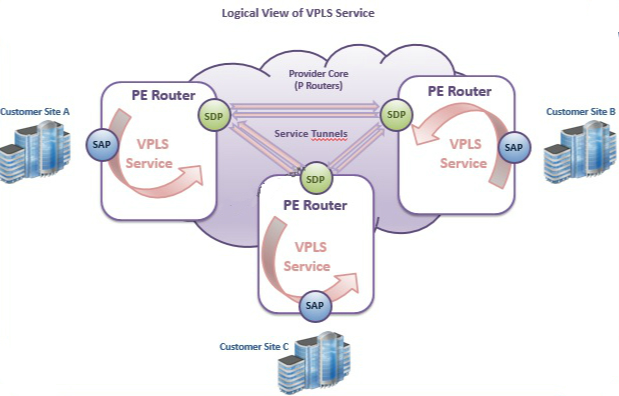Recently, network virtualization technology is the most popular and advanced technology both in our daily life and professional fields. There is a wide range of VPN technology available, such as VPLS and VPWS. Based on the use of Ethernet transport, VPLS and VPWS provide high-speed communications. But many business users who are seeking the most cost-efficient and efficient solutions for their network are confused when they face the two technologies VPLS and VPWS. Here focus on VPLS vs VPWS, to unveil their mysteries.
What Is VPLS?
Virtual private LAN service (VPLS) is a Layer 2 technology that uses MPLS and VPN to connect different LANs over the Internet. It’s a point to multipoint service that enables geographically isolated sites to be connected through a MAN or a WAN. And all services in a VPLS are on the same LAN. CE and PE are the two basic concepts used in VPLS. CE stands for custom edge, which is the device like a router or a 10gbe switch at the customer premises. PE, the provider edge, is defined as the router at the network of the service provider. It’s typically connected with the CE and responsible for VPN access.
How VPLS Works?
Now let’s look at how VPLS works. In VPLS, first, the packet from a service provider network is sent to a CE device (for example, a 48 port 10gbe switch ). Then, the packet is sent to a PE router. It goes through the service provider network via the MPLS label-switched path. At last, when the packet arrives at the exist PE router, it will forward the traffic to the CE device at the destination customer site. For people who implement VPLS on a data switch, they will enjoy a fast, secure and homogeneous network with lower latency.
Figure 1: Example of VPLS
What Is VPWS?
Virtual private wire service or VPWS is built on MPLS network and provides point to point connections that connect end customer sites in a VPN. It’s also a Layer 2 technology that consists of three main elements, PE routers, Label Distribution Protocol (LDP) and Label Switched Path Tunnel. Unlike the traditional VPNs over Layer 2 circuits, which needs extra separate networks for IP and VPN services, VPWS can share the provider’s core network infrastructure between IP and Layer 2 VPN services. Thus, the cost of these services will be reduced. In addition, a VPWS Layer 2 VPN can be a full mesh or a hub and spoke topology. And MPLS is the tunneling in the core network. But other tunneling protocols like GRE also can be used in VPWS.
Figure 2: Example of VPWS
VPLS vs VPWS: What Are the Differences?
From the above, we can see clearly that the biggest difference of VPLS vs VPWS is that the VPLS provides a point to multipoint servers, while the VPWS provides a point to point service. It means that the CE devices of VPLS and VPWS are different. For VPLS, the CE routers just send all traffic to the PE devices. In contrast, in VPWS, CE routers are used to carry out Layer 2 switching and have to decide which virtual wire could be used to send data to another customer site.
Conclusion
As regard with VPLS vs VPWS, we know they both can build a Layer 2 VPN service to meet today’s high speed network requirement. So don’t be hesitated, use your data switches or routers to set up a safety and efficient VPLS or VPWS service to optimize your network.


没有评论:
发表评论